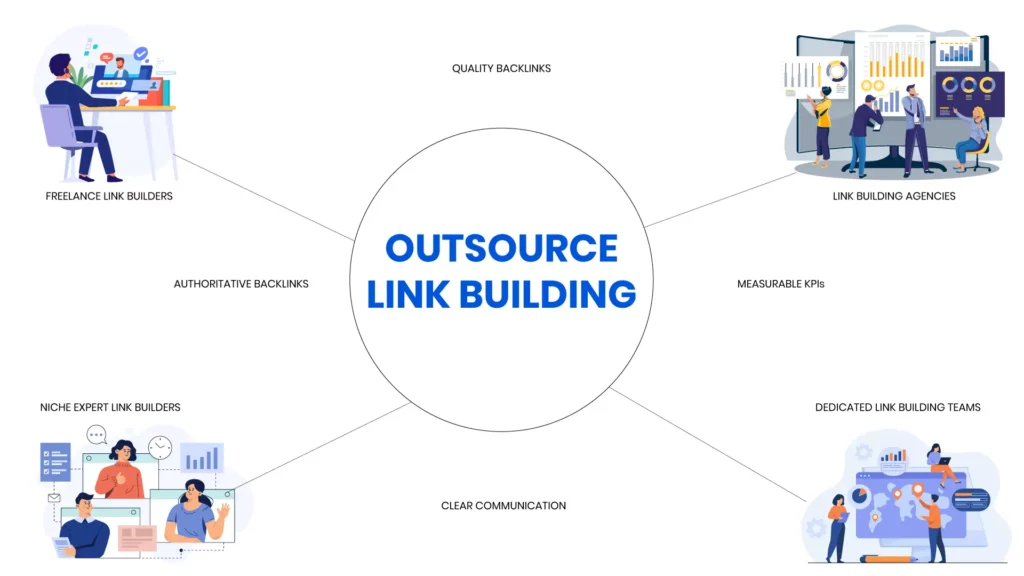This guide is a walk-through that tells us about link building; a crucial SEO strategy for improving your website’s search ranking. We’ll explore hyperlinks, various backlink types, and the distinction between inbound and outbound links.
We’ll then examine how link building influences SEO to amend search results and key SEO metrics like DA and PA. At the end of this blog, you will have an absolute understanding of what link-building means for search engines and your business.
What is Link Building?
Link Building refers to the process of establishing hyperlinks from external websites to your own website, facilitating user navigation across the internet. The purpose of link building is to create a network on the internet focusing the relevance, and authority, to reach the targeted audience, and to improve the webpage metrics like DA, DR, and PA.
Link building facilitates search engine crawlers to discover your website from the internet. The crawler then analyses the destined webpage of your website, including the assessment of inbound link quality. This process refers to crawling. For example, a high PR backlink can significantly enhance your site’s authority and credibility.
Marketers and SEO professionals engage in link building to attract more visitors to their content and improve search engine rankings.
Backlinks have been a crucial ranking factor since the 1990s, with Google’s co-founder Larry Page introducing PageRank to assess page quality.
While Google considers numerous ranking factors, eight of the top twenty are related to backlinks. Andrey Lipattsev, a respected figure at Google, also emphasized the importance of backlinks.
Anatomy of a Hyperlink
To perceive the significance of hyperlinks correctly, it’s crucial to grasp the fundamentals of link creation, how search engines perceive links, and the insights they derive from them. The anatomy of a hyperlink has four different parts:
Anchor Tag (< a >)
This HTML tag is the beginning of the link tag, referred to as an anchor tag <a> initiates the link and indicates to browsers and search engines that a link to another destination will follow.
Hyperlink Referral (href)
The “href” attribute, short for “hyperlink referral,” specifies the destination URL within the quotation marks. This HTML tag has two parts. The first part contains the URL to the pointing web page and the second part is the text/label to show on the screen.
The URL only leads to a webpage but sometimes it could also point to an image or a downloadable file. If a URL contains a “#” sign after the last “/”, it aims to direct the users to a specific section within the same webpage.
Anchor Text
The anchor text of the URL is the text displayed on the page. It is the only part of the href tag visible on the webpage. This text is typically formatted to distinguish it from the surrounding text, often using blue color and/or underlining to indicate its clickable nature. The users can click to open the link.
Closure Tag (< /a >)
The closure of the Anchor tag, represented as </a>, marks the end of the HTML tag. It is important to close it properly.
Types of Backlinks
In Search Engine Optimization (SEO), two types of backlinks count – internal links and external links.
Internal Links
The backlinks created as a result of linking internal web pages to each other are called internal links. For instance, an internal link such as “To learn more about LinkedIn Ads, refer to our comprehensive guide” directs users to related content within the same site.
External Links
The backlinks created as the result of linking webpages to the webpages of other websites are called external backlinks. Think of them as citations in a research paper. By linking to credible sources that support your content, like studies showing the effectiveness of video ads, you establish your authority and trustworthiness in the eyes of search engines and visitors alike.
Inbound Links vs Outbound Links
Inbound links (from other websites) and outbound links (from your website) require strategic planning to manage the link equity or link juice of a webpage. An unstrategic move can harm the website metrics like DA, DR, PA, etc.
In Inbound links, we try to send the users back to our desired webpage from the outer web. enhance search engine ranking. Outbound links direct users away from your website to external resources.
A balanced link profile maximizes benefits from both link types.
Both, the inbound links and outbound links are acquired through content marketing and link-building strategies. Outbound links are implemented as hyperlinks in your content to the outer web.
Each of the link types is valuable when employed strategically. They can improve SEO and drive qualified traffic. However, relevance and user value remain crucial factors.
How to Do Link Building for SEO
Website Audit
Once you’ve decided good for your website and now want to implement link building, the first thing you should do is audit your website. A website audit can unearth technical problems that might hinder search engines from properly crawling and indexing your website. These issues could negatively impact the effectiveness of your backlinks.
A website audit is an important part of planning for a link building campaign. During the audit, we scrape the current content for the quality of the content. We mark every page with proper remarks for the sake of considering link building.
For example, we can address issues like thin content on the website. Our first step is to enrich existing copy by expanding it into more comprehensive and detailed content. We use the Skyscraper Technique to create content that outshines competitors in quality and depth
Then we engage with influential bloggers within our niche, offering them our content for publication on their websites.
The audit can evaluate the quality and relevance of your website’s content. High-quality content attracts natural links organically and serves as a stronger platform for link-building efforts.
Defining Strategy
Opting for the well-suited link-building strategy matters if your goal is to increase your online visibility and gain a competitive edge in your industry. The tricky part here is that not all strategies can yield the same results for every site.
Each website is distinct and characterized by its own set of goals, target audiences, and financial constraints. Consequently, it’s imperative to ascertain the well-crafted link-building strategy tailored to your site’s specific needs and circumstances before committing resources.
Here’s a concise list of link-building strategies, along with the underlying rationale:
Guest posting: Craft an excellent article for the outreached blogger website, including a link back to your own.
Skyscraper technique: The Skyscraper Technique in SEO involves writing the most comprehensive and informative content on a chosen topic, often including data and visuals. This “ultimate resource” then fuels an outreach campaign where you convince the webmaster of the relevant websites to link to your content.
Resource page link building: Identify pages listing resources similar to yours and request inclusion.
Broken link building: Locate dead pages with numerous links, create a substitute on your website, and notify the linking websites.
Image link building: Find websites using your images without proper attribution and request a link.
Unlinked mentions: Request to have mentions of your brand converted into links. It’s always recommended to find a link in the already-written article.
PR: Provide compelling stories for media coverage.
Outreach/Asking for Backlink
Asking for backlinks refers to the practice of contacting website owners/webmasters and requesting a backlink, commonly known as “link outreach.” However, it’s not feasible to approach unrelated (irrelevant) websites.
Note that It’s crucial to target websites that are somehow relevant to your niche and content, as they’re more likely to consider your request. This process of identifying suitable websites to reach out to is termed “link prospecting,” and the more effort you invest in this, the higher your success rate is likely to be.
But why would owners of other websites, even relevant ones, be interested in linking to your page? Ideally, you want them to be impressed with your content to the extent that they naturally want to share it with their visitors. Also, to share a credible source for their visitors by linking to your webpage.
Success in link building relies on three main pillars: content, anchor text, and source page quality. Write Content that corresponds perfectly with the target blog’s theme, making it naturally relevant and valuable to their readers.
The Anchor Text directing traffic to your webpage should be clear, concise, and reflect a compelling value proposition for the blog’s readers. This entices them to click and explore the content on your site.
The Source Page where the link resides (webpage) should offer unique and valuable information for visitors. This reinforces the link’s relevance and strengthens its positive impact on search engines.
Master these Three Pillars for high-quality backlinks!
MagFellow
Link Building through Content Marketing
When you earn links, other websites backlink to yours without you needing to request it. This method can be very cost-effective, and you don’t need to worry about violating Google’s link spam guidelines since you aren’t actively creating the links.
The most effective way to have backlinks is by producing high-quality content that naturally attracts links, often referred to as “link bait.” Here are some types of content that tend to attract links:
- Visual assets like infographics, charts, and diagrams.
- Original research and data such as industry studies and surveys.
- Online tools and calculators.
- Comprehensive guides and tutorials.
- Newsletter
- Email Marketing
- Ebooks
- Video and Audio Podcast
Backlinking occurs when other people backlink to your website’s pages because they find them noteworthy and valuable. This typically happens when your website offers:
- Your company’s exclusive data, like the About Us page.
- Results of significant experiments, like Case Studies.
- Unique ideas and strong viewpoints in the content
- Industry surveys.
- Timely breaking news.
If you’re thinking about attempting the link-building process independently, you need to have a second thought. It’s far more complex than it sounds. Professional link-building services often come with a team of experts having extensive experience and knowledge in the field, ensuring that your strategies are well-informed and executed effectively.
Investing in link-building services can yield higher-quality links, faster results, and ultimately, better returns on your investment compared to attempting to navigate the complexities of link-building on your own.
Is it Advisable to Buy the Backlink?
You should avoid purchasing SEO links with the intention of manipulating your rankings. In other words, you should only pay for backlinks if they are qualified with the “rel=sponsored” or “rel=nofollow” attribute, indicating to search engines that they should be ignored.
If a paid link lacks qualification:
- Both sites risk being penalized for violating Google’s link spam guidelines.
- Google is likely to recognize the paid nature of the link and disregard it.
- There’s also the risk of wasting money on ineffective links that provide no benefit.
That being said, we don’t want to recommend any tactics that might put your business or your wallet at risk. To clarify, while you can pay for link-building services from a freelancer or agency, the websites hosting your backlinks should not receive any form of payment.
What are the website metrics? DA and PA in SEO?
Website metrics refer to different measures or metrics to assess the website for a specific parameter. For example, Domain Ranking (DR) is a metric developed and introduced by Ahrefs, an all-in-one SEO tool, to measure the overall rating of a domain.
Similarly, DA (Domain Authority) and PA (Page Authority) are metrics developed by Moz to assess the strength and authority of a website’s domain and individual pages, respectively. Here are some important metrics to consider when selecting a website for creating backlinks.
Domain Authority (DA)
Domain Authority (DA) is a measure of the overall authority and credibility of a website’s domain. It’s calculated based on various factors, including the quality and quantity of backlinks pointing to the domain, as well as other website metrics. A higher DA score indicates a stronger and more authoritative website, which can potentially lead to better search engine rankings.
Page Authority (PA)
Page Authority (PA), is a metric that assesses the authority of a specific page on a website. Like DA, it’s calculated based on factors such as backlinks and other on-page and off-page elements. A higher PA score suggests that a particular page is more likely to rank well in search engine results.
Domain Rating (DR)
Domain Rating (DR), developed by Ahrefs, measures the strength of a website’s backlink profile. It’s based on the quantity and quality of backlinks pointing to the entire domain
Organic Traffic
The organic Traffic metric represents the count of visitors who land on a website through unpaid, or organic, search engine results. It serves as a crucial indicator of a website’s visibility and popularity within search engines.
Spam Score
Spam Score, also provided by Moz, predicts the likelihood of a website being penalized or banned by search engines due to spammy or low-quality backlinks. A higher spam score indicates a higher risk of being penalized.
Referring Domains
Referring domains are websites that link back to a particular domain. Having a diverse and authoritative set of referring domains can positively impact a website’s SEO performance.
Link Placement
Link Placement refers to where a backlink is placed within the content of a webpage. Backlinks placed within relevant, high-quality content tend to carry more weight and have a greater impact on SEO compared to links in less relevant or lower-quality content.
How Many Backlinks Are Good for SEO?
For determining the right amount of backlinks good for Search Engine Optimization, the best strategy is to highly observe what your top 5 competitors are doing. Don’t forget the top-ranking web pages of the competitors for organic traffic and backlinks.
Heightening your site’s overall health is the initial step toward attaining comparable organic traction for your targeted pages. Building relevant and credible links comes after this.
For instance, if your competitor’s homepage has 35-45 backlinks, aiming for a range of 40-50 backlinks would be strategic. This methodology should be replicated across various web pages, including but not limited to the homepage and key service/product pages.
Note: The impact of these backlinks on rankings varies depending on their PageRank score. A higher PageRank score means that fewer links are required for overall rankings. Obtaining a single high PR9 backlink is more effective than acquiring ten PR1 backlinks.
Are Backlinks Free? Costing and Budgeting
The cost of acquiring a backlink is directly tied to the quality of the source website, as measured by various SEO metrics like Domain Rating (DR), Domain Authority (DA), Spam Score, and Trust Flow. Generally, backlinks from high-authority websites with strong reputations will command a steeper price compared to those from lower-authority sites.
For illustration purposes, based on our experience, a backlink from a website with a DR of 45 might range from $350 to $550. It’s crucial to remember that cost alone shouldn’t be the sole deciding factor. Prioritize acquiring backlinks from thematically relevant websites with a natural placement within the content to ensure maximum SEO value and organic traffic potential.
What are Good and Bad Links?
Good Link/High-quality Backlink
A good link typically originates from websites with strong domain authority and content that topically aligns with the target page.
Bad Link/ Private Blog Network (PBN)
Private Blog Networks (PBNs) are widely regarded as black hat SEO techniques and can incur severe penalties, including being de-indexed or banned. According to Google’s guidelines on link spam, any links designed to manipulate rankings in Google Search results are categorized as bad links or toxic links.
Benefits of Link Building | Why Links Matter for SEO?
Link building improves your site’s local and technical SEO, propelling your search ranking upward. Below, discover five potent methods to benefit your website through effective link-building strategies.
Increased Website Rankings
The significance of link building in determining your website’s Google ranking cannot be overstated. Without backlinks, even the highest quality content may struggle to achieve visibility. According to Google My Business, backlinks contribute approximately 17% to the ranking of your website in local Google searches. Backlinks are important for web crawlers, informing them of your site’s presence and relevance.
Improved Website Metrics
Engaging in link building assists in increasing various metrics associated with your website, including Domain Authority (DA), Domain Rating (DR), PageRank (PR), and Alexa Rank, among others. Improving your site’s DR is a crucial aspect of strengthening its SEO significance.
In Search Engine Optimization (SEO), website metrics are measured for assessing the quality and effectiveness of a website. These metrics span a range of categories, including website performance metrics (also known as SEO metrics), UI/UX metrics, conversion metrics, social media marketing metrics, email marketing metrics, content marketing metrics, public relations (PR) metrics, paid advertising metrics, app engagement metrics, and security metrics.
An essential metric in assessing your website’s authority is its domain rating. Acquiring backlinks from high DR pages with a do-follow attribute contributes to increasing your website’s authority and ranking.
Website metrics play a crucial role in link building. They help assess the value of a backlink. A backlink accompanied by strong metrics is consistently regarded as a good backlink.
Established Authority
Link building enables you to establish a prominent presence in your industry. A standout website enhances the authority and credibility of your brand, leading to increased sales and revenue. With an authoritative brand, you can effectively outshine competitors in your field.
Increased Website Visibility and Exposure
Link building also helps bring in genuine leads by making your website more visible to your audience. If you’re trying to reach a specific group in a specific area, link-building can help people there discover you. This is good for your business and shows that your website is reliable.
How Else Can Link Building Benefit My Business?
Link building offers significant advantages beyond just improved organic search rankings and traffic.
High-quality links can be acquired naturally through other strategic activities. For instance, launching a genuinely innovative product or creating the industry’s best content guide can generate organic links to your website.
The primary focus of these activities shouldn’t be link acquisition, but rather product development or content creation excellence. Backlinks are a positive consequence, not the initial goal.
Link building should be viewed as an integrated strategy that connects with various aspects of your organization, with benefits extending beyond the backlinks themselves. Here’s what else your business would achieve:
Building Relationships
Link building often involves outreach to relevant industry websites and blogs. This outreach typically promotes newly created content or infographics.
While securing backlinks is a common goal, outreach offers broader benefits. It stimulates long-term relationships with key industry influencers for the sake of brand building, reputation, and trust.
By attaining genuine brand advocates, you establish a positive brand image. In ideal scenarios, strong relationships can lead to inbound inquiries from writers or journalists seeking your expertise, flipping the traditional outreach purpose. This approach is referred to as HARO backlinking.
HARO (Help a Reporter Out) facilitates source discovery for journalists and bloggers seeking expertise for their articles. This free platform distributes daily emails categorized by industry (business, lifestyle, marketing, etc.), allowing users to establish backlinks.
Sending Referral Traffic
Backlinks can significantly impact referral traffic. High-authority, high-traffic websites linking to your content can drive relevant visitors to your site. This targeted traffic increases the likelihood of lead generation and sales.
The value of a backlink transcends SEO, focusing on customer acquisition. Strategic link placement exposes your brand to a pre-qualified audience interested in your offerings. While immediate conversions may not occur, brand awareness and consideration are established.
Brand Building
Effective link-building strategies contribute to brand-building and industry authority. Techniques like content creation showcase company expertise, encouraging brand recognition.
For instance, publishing data-driven content establishes topical authority within your niche. Subsequent outreach efforts promoting the content reinforce expertise and encourage industry peers to share it, amplifying brand visibility.
Final Words
Even if you create a fantastic post, it might go unnoticed if search engines can’t find at least one link to it. Link building takes time and effort; it’s not a quick fix for success. Hopefully, this guide has helped you understand link building better, so you can approach it with confidence.
Frequently Asked Questions About Link Building
For optimal SEO, prioritize white hat link building. This long-term strategy emphasizes creating high-quality content and building relationships with relevant websites to earn natural backlinks. White hat tactics comply with Google’s search guidelines, ultimately strengthening your brand’s organic ranking for targeted keywords.
Technical SEO refers to the steps taken by a website owner to make it easier for search engines to crawl and index. And link building is indeed one of the methodologies. Link building is one of the off-page SEO techniques that contribute to your ranking in search engine results pages.
To speed the process of backlinking, adopt these strategies:
- Offer Yourself as a Source to Reporters and Bloggers
- Create High-Quality “Skyscraper” Content
- Obtain Links From Obsolete Resources
- Employ Content Formats Made to Attract Links
- Produce Comprehensive Ultimate Guides
- Implement Branded Strategies and Techniques
- Secure Links from Authoritative Resource Pages
- Transform Brand Mentions Into Valuable Backlinks




